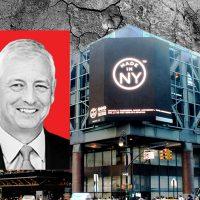Things were going great for the Port Authority until Covid-19. Now it’s asking Washington for billions of dollars. Sound familiar?
In some ways, the bi-state agency is better positioned than Gov. Andrew Cuomo and Mayor Bill de Blasio, who are looking for a combined $24 billion from the Trump administration and Congress, and the Metropolitan Transportation Authority, which wants $13 billion.
For one thing, the Port Authority is requesting only $3 billion. For another, it doesn’t have the political tinge that make Cuomo and de Blasio unpopular with D.C. Republicans, or the MTA’s reputation for overspending. It also is not a regular at the federal trough, having been a self-funded agency for decades.
Read more


But the pandemic wiped out much of the revenue the Port Authority of New York and New Jersey reap from its airports (John F. Kennedy International, LaGuardia, Newark), bridges and tunnels (George Washington, Goethals, Bayonne, Outerbridge, Holland, Lincoln), and trains (AirTrain and PATH).
Vehicular traffic is back within 10 percent of normal, and shipping at the agency’s ports is now above its level of a year ago. However, airport activity is still down 80 percent, said Rick Cotton, executive director of the agency, during a TRD Talk last week.
One revenue generator for the authority would be to sell to housing developers its 80 acres of waterfront land in Red Hook, where it has a small container operation.
“We understand that in terms of its land, it’s not the highest and best use,” Cotton said. “We’d absolutely be prepared to work with the city, state and community in terms of enabling development on that site.”
But that would require cooperation between Cuomo and de Blasio, who struggle to agree on the time of day.
Cotton noted that regardless of what happens with the Red Hook site, shipping will continue somewhere in Brooklyn. Operations could be moved to the South Brooklyn Marine Terminal in Sunset Park. The bistate agency has been talking with de Blasio’s Economic Development Corporation, which owns the terminal.
The executive director also discussed office leasing at the World Trade Center (“The big picture is it’s going extraordinarily well”) and rebuilding the Port Authority Bus Terminal (“We will publish our new proposal well before the end of the year”).
The bus terminal, on Eighth Avenue and West 42nd Street, will involve a revenue-generating private component to help cover the cost, which could exceed $10 billion. “Infrastructure is expensive,” Cotton said. “But we need to get on with it.”
Funding the authority’s $37 billion capital plan is Cotton’s primary concern. The agency aims to spend $2 billion building an AirTrain from LaGuardia to Willets Point and another $2 billion replacing Newark’s aging AirTrain and connecting it to the PATH. An $8 billion overhaul of LaGuardia Airport is underway, as are multibillion-dollar renovations of JFK and Newark airports. Much of the airport work is privately funded.
“For every dollar that goes into these projects, we’re going to attract $5 to $10 of private investment … which will generate jobs, attract other economic activity, and enable our airports to be an attraction, as opposed to something the region frequently is embarrassed by,” said Cotton.
Now the authority must convince the federal government that its projects, which would take years to complete, would help the nation recover from the pandemic.
“These are projects that look four to five years into the future,” he said. “This is about the future of the region.”